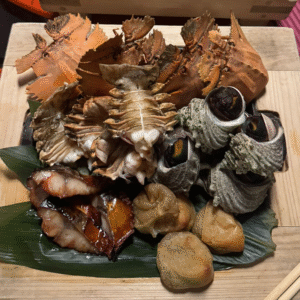17-year-old on why food is the best way to experience new cultures

A shellfish platter served to Reva at a Chinese-Japanese restaurant in Nagasaki, Japan.
Picture by: Harbingers' Magazine
Article link copied.
Some people eat to live, but I live to eat.
One of my biggest blessings in life is not being a picky eater, because it opens me up to exploring a whole new facet of culture that often is underappreciated – food.
As a connoisseur of good food I come from a place of authority when I say that one of the best ways to know a culture or experience a new country is to know the food.
Food is so much more than just the actual taste of the meal, it’s the history it carries, the way it’s served, and the care that goes into preparation.
Most recently I can speak to what I’ve learned about Japan through my meals.
Harbingers’ Weekly Brief
First, customs – Japan is deeply rooted in a culture of politeness known as the concept of teinei. From the moment you enter a restaurant, you are greeted by dutiful bowing and an enthusiastic Japanese phrase, Irasshaimase!, meaning “Welcome, please come in.” This politeness persists all throughout the meal, as the entire restaurant staff is committed to treating their guests with the utmost respect.
However, the respect should be mutual. Certain traditional restaurants will require you to take off your shoes and it doesn’t hurt to bow back to express your gratitude for their service and for the meal. Just take the noren, flags hung on nearly every restaurant’s doors – they are there to advertise, but also cause a patron to bow as they enter and avoid brushing the flags while simultaneously showing respect.
It’s hard to truly understand the extent of Japanese politeness unless you sit down for a meal and just take a moment to experience the care with which they treat each diner.
There was no better moment of realisation of the amount of dedication the employees put into their work than when one of the servers ran down the street and into the convenience store over a pack of cards and then found us again to return a twenty-cent Hong Kong coin (US $0.26) which one of us left at the restaurant.
We weren’t even exceptional customers for her to go so above and beyond for us. Quite the contrary – we proved to be difficult for her to serve due to the language barrier, but that still didn’t stop her from providing us with excellent service that exceeded our expectations.
Restaurants are one of the only ways to enjoy the local culture and people beyond the experiences curated for tourists. Dining is for everyone so if you want to taste a country like the locals do you have to eat like the locals do.
Beyond just the country’s restaurant culture, the food itself has a lot to say about a country as a whole.
If you’re not a big history buff or have already maxed out on the amount of museums you can see in one trip, explore the local cuisine. While museums and historical displays are a great way to learn traditions and culture, there is something so tangible, raw, and intimate about the history felt while indulging in a meal indigenous to a region.
Food can tell us about multicultural exchanges through ingredients and preparation methods. Food can reflect a country’s hardships and struggles. Food can hold the resilience, bravery and innovation of people who are no longer around to share their stories.
Hiroshima-style Okonomiyaki, one of the first meals we had in Japan, is a savory cabbage pancake layered with various meats, egg and noodles depending on personal preference and variance.
Okonomiyaki is said to have roots in a 16th century sweet pancake, funoyaki, consumed at Buddhist ceremonies. During the Meiji era (1868-1912) the dish received a new name, mojiyaki, as it spread around Japan.
Okonomiyaki, the beloved savory dish consumed today, was not popularised until World War II after it had picked up Western influences like Worcestershire sauce and had forgone the rice amidst war-driven scarcity of the grain Okonomiyaki became a comfort meal as it was cheap, tasty, and could be prepared with an array of ingredients depending on the availability. The dish serves as a testament to the strength of the Japanese citizens during war and adversity better than any history book could explain.
One thing everyone has to do is eat, so why not make the most of your time in the country by using your meals to maximise your immersion in the local culture.
Food truly provides a window into the soul of the country, so make the most of it.
Written by:

The Harbinger Prize 2024 (Overall Winner)
Writer
United States
Reva Sobti was born in 2008 and currently studies in the United States. She plans to pursue a higher education at one of the T-25 universities to major in Sociology, Business, or Biology. Reva won the Harbinger Prize 2024 and plans to continue writing about social issues.
After successfully completing the Essential Journalism course, Reva became a writer for Harbingers’ Magazine starting in March 2025.
In her free time, she loves to read, watch movies, bake, play volleyball, and eat good food. A fan of travelling, Reva has so far visited 16 countries.
She speaks English, Hindi, Punjabi and Spanish.
🌍 Join the World's Youngest Newsroom—Create a Free Account
Sign up to save your favourite articles, get personalised recommendations, and stay informed about stories that Gen Z worldwide actually care about. Plus, subscribe to our newsletter for the latest stories delivered straight to your inbox. 📲
© 2025 The Oxford School for the Future of Journalism



